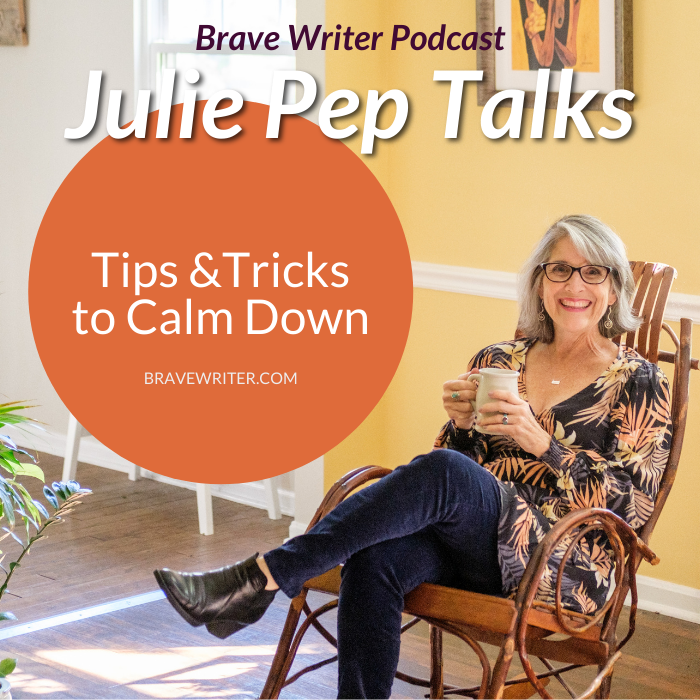Podcast: Tips & Tricks to Calm Down

Last week on the Brave Writer podcast we discussed how the path to giving our kids the best possible outcomes in life comes down to some counterintuitive advice: You have to think – and care – less about that outcome. Easy, right? Maybe not.
Now that you’ve hopefully bought into the theoretical concept, we’re going to dive into more practical advice about how to apply it. I’m going to offer tips and tricks for caring less and calming down – both for yourself and for your child.
Show Notes
Breathe In, Breathe Out
When faced with an abundance of chaos or overwhelm in the household, we naturally and instinctively draw in air, fill up our bellies, and exhale slowly as a way of calming the nervous system.
But our children may not take requests to “calm down and breathe” very well. They quickly learn to take this as a control mechanism – something you force them to do to make yourself feel more comfortable. They’re already doing what makes them feel better, even if that behavior is disruptive to you.
So how do we combat this? How do we allow our kids to regulate their emotions in ways that aren’t overly destructive or disruptive to our own health and sanity? According to educator, Joshua McNeil, you create hidden “brain breaks.” We want to allow our kids to have the space to make a good decision without losing face or feeling embarrassment and shame over their decision.
Brain Breaks
These come from the book 101 Brain Breaks & Brain Based Educational Activities by Joshua McNeal. Try these techniques to give your kids the break they need without forcing them to do something they don’t want to do or making them feel embarrassed:
- Paper Football Breathing: Create a paper football (one of those triangle origami ones), and clear off a table. Put the football at one end of the table and invite your kids to blow the football from one end of the table to the other so that it hangs on the edge without falling off. This requires some controlled breathing but wrapped up in a fun game.
- Hum, Hum, Hum: Humming along to a favorite song forces you to take a deep breath and relax. It vibrates your face and loosens the muscles that get tense when you are angry or stressed.
- Bubble Blowing: Keep a bottle of bubbles hidden under your sink, and, when chaos breaks out, just start blowing bubbles in the direction of the disruption. The breathing required to blow bubbles will calm you down, and it creates a magical environment that will delight your child and slow them down.
Our job is not to talk our kids into better behavior. Our job is to model and provide alternatives. We need to lead wordlessly with our own behavior, and we need to make these de-stressing behaviors pleasurable. Keep these in your back pocket and don’t use them every day, because repetition will cause them to lose their power. Help your kids regulate and renew their energy for the next step in their day.
Resources
- Raising Critical Thinkers comes out February 1st, 2022. Be sure to pre-order by January 30th to get an exclusive pre-order bonus!
- Neurologic® Initiative
- Read: 101 Brain Breaks & Brain Based Educational Activities
- Want help getting started with Brave Writer? Head over to bravewriter.com/getting-started
- Sign up for the Brave Writer newsletter to learn about all of the special offers we’re doing in 2022 and you’ll get a free seven-day Writing Blitz guide just for signing up: http://go.bravewriter.com/writing-blitz
Connect with Julie
- Instagram: instagram.com/juliebravewriter
- Twitter: twitter.com/bravewriter
- Facebook: facebook.com/bravewriter
Tags: Julie Pep Talks


















